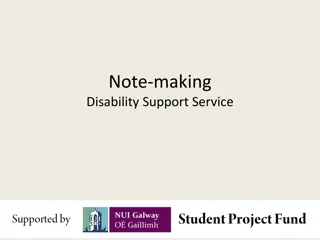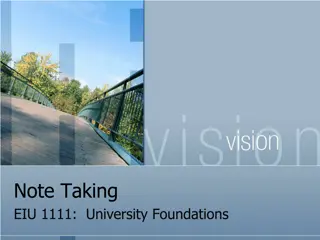The Art of Effective Note-Taking and Reviewing for Enhanced Learning
Learn the importance of effective note-taking in enhancing learning through active working memory and creative methods like graphic organizers, matrices, concept maps, and mind maps. Discover different note-taking representations to improve information retention and understanding. Explore the benefits of reviewing notes to encode information into long-term memory.
Download Presentation

Please find below an Image/Link to download the presentation.
The content on the website is provided AS IS for your information and personal use only. It may not be sold, licensed, or shared on other websites without obtaining consent from the author. Download presentation by click this link. If you encounter any issues during the download, it is possible that the publisher has removed the file from their server.
E N D
Presentation Transcript
Note-taking The importance of effective note- taking (Seli, Dembo, 2020) Active working memory Enhances learning through senses College success component Creative note-taking (Makany, Kemp, Dror , 2009) Learn and retrieve Better understanding Prior knowledge of visual representations
Outlines (McPherson, 2011) Figure 1. Graphic Summaries. From Effective Notetaking, 2011, p.71
Graphic Organizers (McPherson, 2011) Figure 2. Graphic Summaries. From Effective Notetaking, 2011, p.72
Matrix (Dembo, Seli, 2020, Kiewra et al, 1991) Figure 2. Matrix. From Effective Notetaking, 2011, p.72
Multimedia Summaries (McPherson, 2011) Figure 6. Graphic Summaries. From Effective Notetaking, 2011, p.78
Concept Maps (McPherson, 2011) Figure 3. Concept Maps. From Effective Notetaking, 2011, p.127
Mind Maps (Buzan, 2002) Figure 3. Planning a Presentation Mind Map. From How to Mind Map, 2002, p.44
Constructing Different Note-taking Representations (Dembo, Seli, 2020) Sequence: first, before, in the center, lower, outside, after, next, last, steps stages phases cycle as a result consequently therefore Hierarchy: Kinds of Types of Classified as Composed of Parts of Groups of Properties of Characteristics of Perspectives Matrix: Like Similarly equally in contrast On the other hand Alternatively Similar In comparison Diagrams: Parts, appearance, position, movement
Reviewing Notes (Kiewra et al, 1991) Review notes before or after class Helps encode information into long term memory
References Buzan, T. (2002). How to mind map. London, UK: Thorsons. Dembo, M., & Seli, H. (2020). Motivation and learning strategies for college success: a focus on self-regulated learning. New York, NY: Routledge. Kiewra, K.A., DuBois, N.F., Christian, D., McShane, S., Meyerhoffer, M., & Roskelley, D. (1991). Note-taking functions and techniques. Journal of Educational Psychology, 83 (2), 240- 245. doi:10.1037/0022-0663.83.2.240 Makany, T., Kemp, J. and Dror, I.E. (2009), Optimising the use of note-taking as an external cognitive aid for increasing learning. British Journal of Educational Technology, 40: 69-635. doi:10.1111/j.1467-8535.2008.00906.x McPherson,F. (2011). Effective notetaking. Wellington, NZ: Ways Press.






























